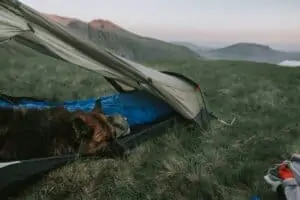Is Mold in a Tent Dangerous?

Is mold in a tent dangerous? Some will say no, but I would err on the side of caution and avoid sleeping in a tent if I see mold.
Depending on the mold growth type, you could expose yourself and anyone sleeping in that tent to spores that can be detrimental to your health.
To make a blanket statement and tell you that it’s fine to sleep in a tent with mild mold would be a disservice.
Why?
Because not everyone will experience the same type of mold growing in their tent.
You can take a guess and determine if the mold is toxic or not, but I’m no mold expert, and I’m sure many of my readers aren’t either.
Why risk it?
Most people won’t realize there’s mold inside their tent until their next camping trip.
If your only options were to sleep in the cold or in your tent, then you’d choose your tent.
However, let’s not get to that scenario.
I’ll discuss preventative measures to keep mold out of your tent permanently, so they don’t become hazardous.
What is Mold?
Mold is a type of fungus that grows in damp, dark places. It can be found indoors and outdoors, on walls, floors, furniture, clothing, and other surfaces. Mold often appears as fuzzy or slimy patches of various colors, such as green, black, or white.
What Does Mold Look Like?
Mold typically looks like spots or patches of fuzziness on the surface it’s growing on. The color can range from black to green to white, depending on the species of mold present. Some molds may also have an unpleasant musty odor associated with them.
Where Does Mold Grow?
Mold prefers warm and humid environments with plenty of moisture to thrive in. Common places you might find mold include bathrooms (especially around showers), basements, attics, and crawl spaces. Water leaks are more likely due to poor ventilation or plumbing issues.
Outdoors, it can be found in soil near plants that don’t get enough sunlight or air circulation which causes the area to stay moist longer than normal, allowing mold spores to settle down and start growing colonies quickly if conditions remain favorable for long periods without any disruption from humans or animals passing through regularly disturbing their environment.
What Causes Mold To Grow In A Tent?
Mold is a fungus that can grow in damp, dark environments and can be dangerous if not addressed properly. To understand the risks associated with mold in tents, it’s important to know how to identify and remove it and prevent future growth.
Is Mold in a Tent Dangerous?
Mold in a tent can be dangerous and cause health risks to those who sleep in it. Mold is caused by moisture, which can come from humidity, condensation, or water leakage. It appears as spots on the tent’s fabric and may have an unpleasant musty smell. If left unchecked, mold can spread quickly and become a serious health hazard.
Health Risks of Sleeping in a Tent with Mold
People sleeping in tents with mold are at risk for respiratory illnesses such as asthma attacks or allergic reactions due to inhaling spores released by the mold. In addition, people with weakened immune systems are more susceptible to infections caused by molds that produce toxins called mycotoxins.
These toxins can cause skin irritation, eye inflammation, fever, headaches, and other symptoms depending on how long you’ve been exposed to them.
Mold in a tent can be dangerous and cause health risks to those who sleep in it. Mold is caused by moisture, which can come from humidity, condensation, or water leakage. It appears as spots on the tent’s fabric and may have an unpleasant musty smell. If left unchecked, mold can spread quickly and become a serious health hazard.
People sleeping in tents with mold are at risk for respiratory illnesses such as asthma attacks or allergic reactions due to inhaling spores released by the mold. In addition, people with weakened immune systems are more susceptible to infections caused by molds that produce toxins called mycotoxins.
These toxins can cause skin irritation, eye inflammation, fever, headaches, and other symptoms depending on how long you’ve been exposed to them.
Mold in a tent can be dangerous to your health, but with the proper cleaning and disinfecting methods, you can prevent the future growth of mold and keep yourself safe.
How to Clean and Disinfect a Tent with Mold
The first step in cleaning a tent with mold is to clean the exterior. This can be done using a mild detergent and water solution, such as dish soap or laundry.
Make sure to use warm water when mixing your solution, as this will help loosen any dirt or debris that may have accumulated on the tent fabric.
Once you’ve mixed your solution, use a soft-bristled brush to scrub any visible mold spots outside your tent. Then, rinse the area thoroughly after scrubbing and let it air dry before moving on to the next step.
Cleaning the Interior of the Tent with Vinegar or Baking Soda Solution: Mix up vinegar or baking soda solution (or both) to clean out any mold inside your tent.
For vinegar, mix one part white vinegar with four parts water; for baking soda, mix two tablespoons of baking soda per quart of warm water. Use a damp cloth dipped in either mixture to wipe down all surfaces inside your tent, including walls and floors. Let it sit for about 10 minutes before rinsing off completely with fresh water and letting it air dry before proceeding further.
If there are still stubborn areas where mold has not been removed from either side of your tent fabric, then you may need to resort to using bleach or other disinfectants like Lysol spray on these areas only (not recommended for tents made out of synthetic materials).
Mix one cup of bleach into five gallons of warm water and use this mixture sparingly on affected areas only – do not saturate entire sections at once. After applying this mixture, allow it to sit for 15 minutes before rinsing off completely with fresh cold water and allow everything to air dry once more before storing or using it again.
Cleaning and disinfecting a tent with mold is essential to ensure the safety of those using it. Taking proper steps to repair or replace any damaged parts and drying out the cleaned tent will help extend its lifespan and keep you safe when camping outdoors.
Can You Save a Moldy Tent?
Mold can be a serious problem for campers, as it can quickly spread and cause damage to tents. Fortunately, there are ways to save a moldy tent if the infestation is caught early enough. The first step in saving your tent is assessing the damage caused by the mold.
Look for discoloration or staining on your tent’s fabric, as well as any visible signs of mildew or fungus growth. If you find any areas that have been affected by mold, they will need to be repaired or replaced before you attempt to clean and disinfect your tent.
Next, repair or replace any damaged parts of the tent that may have been affected by the mold. This could include replacing zippers, patching holes in the fabric, and reinforcing seams with waterproof tape. Once all repairs are complete, it’s time to start cleaning and disinfecting your tent with either vinegar or baking soda solution mixed with water; use bleach only if necessary since it can weaken fabrics over time. Make sure to scrub away all visible signs of mold from inside and outside surfaces using a soft brush or cloth dampened with soapy water before rinsing thoroughly with clean water afterward.
Although cleaning and repairing a moldy tent can be arduous, it is possible to salvage your tent if the damage isn’t too severe. If you’re not up for the challenge, alternatives like commercial products or professional services may help you eliminate mold.
Are There Alternatives to Cleaning a Moldy Tent?
Using Commercial Products for Removing Molds from Tents: Many commercial products are available to help remove molds from tents. These products usually contain a combination of ingredients such as chlorine, bleach, and other cleaning agents that can be used to kill mold spores.
When using these products, following the instructions carefully and using protective gear such as gloves and eye protection when handling them are important. Additionally, some of these products may not be suitable for certain fabrics or materials, so it is important to read the label before using them on your tent.
Using Natural Solutions for Removing Molds from Tents
Natural solutions can also be used in place of commercial products for removing molds from tents. Some common options include vinegar or baking soda mixed with water which can be sprayed onto affected areas and left overnight before wiping off with a damp cloth.
Essential oils like tea tree oil have also been known to work well against mold growth due to their antifungal properties. Still, they should always be diluted in water before being applied directly onto fabric surfaces.
If you don’t feel comfortable tackling this task yourself, professional services are available that specialize in cleaning tents affected by mold growth. They will typically use specialized equipment such as high-pressure steam cleaners or chemical treatments depending on the problem’s severity upon inspection.
It is recommended that you get an estimate first since costs can vary significantly depending on how much work needs to be done and what type of treatment they recommend using on your tent fabric.
Although there are several ways to clean a moldy tent, it is best to prevent future growth of molds in your tent by storing camping gear properly when not in use, keeping the campsite dry and well-ventilated, and regularly inspecting for signs of moisture or mildew.
How to Prevent Future Growth of Molds in Your Tent
Storing Your Camping Gear Properly When Not In Use: It is important to store your camping gear properly when not in use. This means keeping it dry and away from any moisture or dampness.
If possible, keep your tent stored indoors in a cool, dry place like a closet or garage. Make sure the area is well-ventilated so that air can circulate around the tent and help prevent mold growth.
Keeping Your Campsite Dry and Well-Ventilated
To prevent future mold growth in your tent, make sure to keep your campsite as dry as possible.
Avoid setting up camp near bodies of water or other sources of moisture, such as streams or ponds.
Make sure there are no puddles on the ground where you will be pitching your tent, and try to find an area with good airflow for optimal ventilation while sleeping at night.
Regularly inspecting your campsite for signs of moisture or mildew is essential for preventing future mold growth in tents. Look out for wet spots on the ground, discoloration on walls/roofs/floors, musty odors from fabrics/clothing items inside the tent, and visible patches of mold growing anywhere near the campsite itself.
If you notice any signs of potential mold growth, immediately clean up any affected areas with a disinfectant solution before packing up camp again and heading home safely.
Following the tips outlined in this article can help prevent mold from growing in your tent and keep yourself safe while camping.
FAQs
Can I sleep in a tent with mold?
No, it would be best if you did not sleep in a tent with mold. Mold can cause serious health problems if inhaled or touched. It is important to thoroughly clean and dry any tents exposed to moisture before use.
If there are visible signs of mold growth, it is best to discard the tent and purchase a new one.
Make sure your tent has adequate ventilation so that condensation does not build up inside the tent and lead to further mold growth.
Can you wash mold out of a tent?
Yes, you can wash mold out of a tent. First, remove any items inside the tent and set them aside. Then mix one part bleach with four parts water in a bucket or spray bottle and use it to spot-clean any visible mold on the tent fabric.
Allow the solution to sit for 10 minutes before rinsing it with cold water. Once all visible signs of mold are gone, air-dry your tent completely before storing it away or using it again.
What do you do with a moldy tent?
If your tent has become moldy, it is important to take immediate action. Start by airing out the tent and cleaning off any visible mold with a damp cloth or sponge.
If possible, wash the tent in a washing machine on a gentle cycle using cold water and mild detergent.
Once washed, dry the tent completely before storing it away. Store your tent in a well-ventilated area free from moisture to prevent mold growth. Additionally, use a dehumidifier or air purifier to reduce humidity levels in the storage space.
Before You Go
If you’re new to camping or even a vet , check out these resources below:






